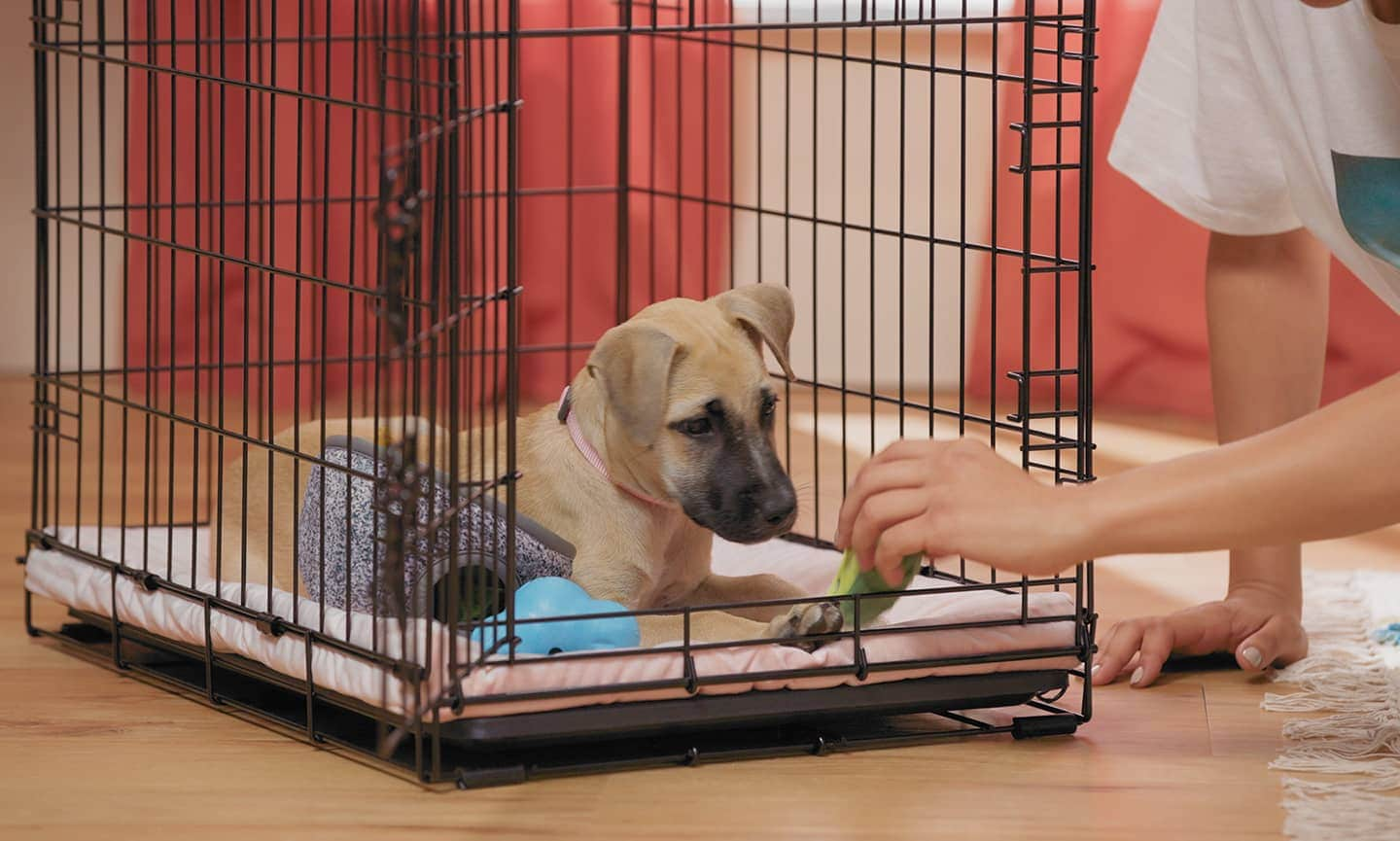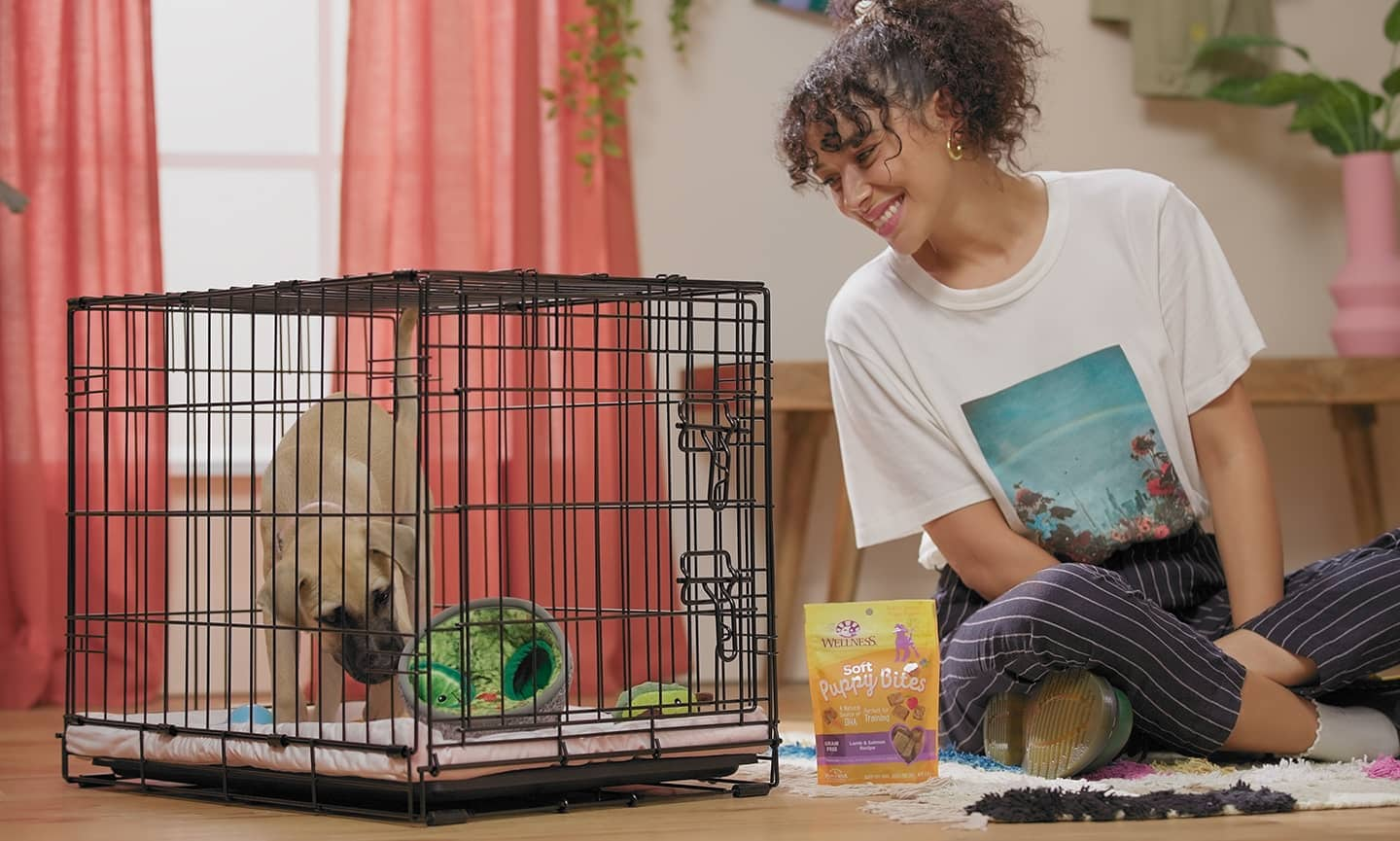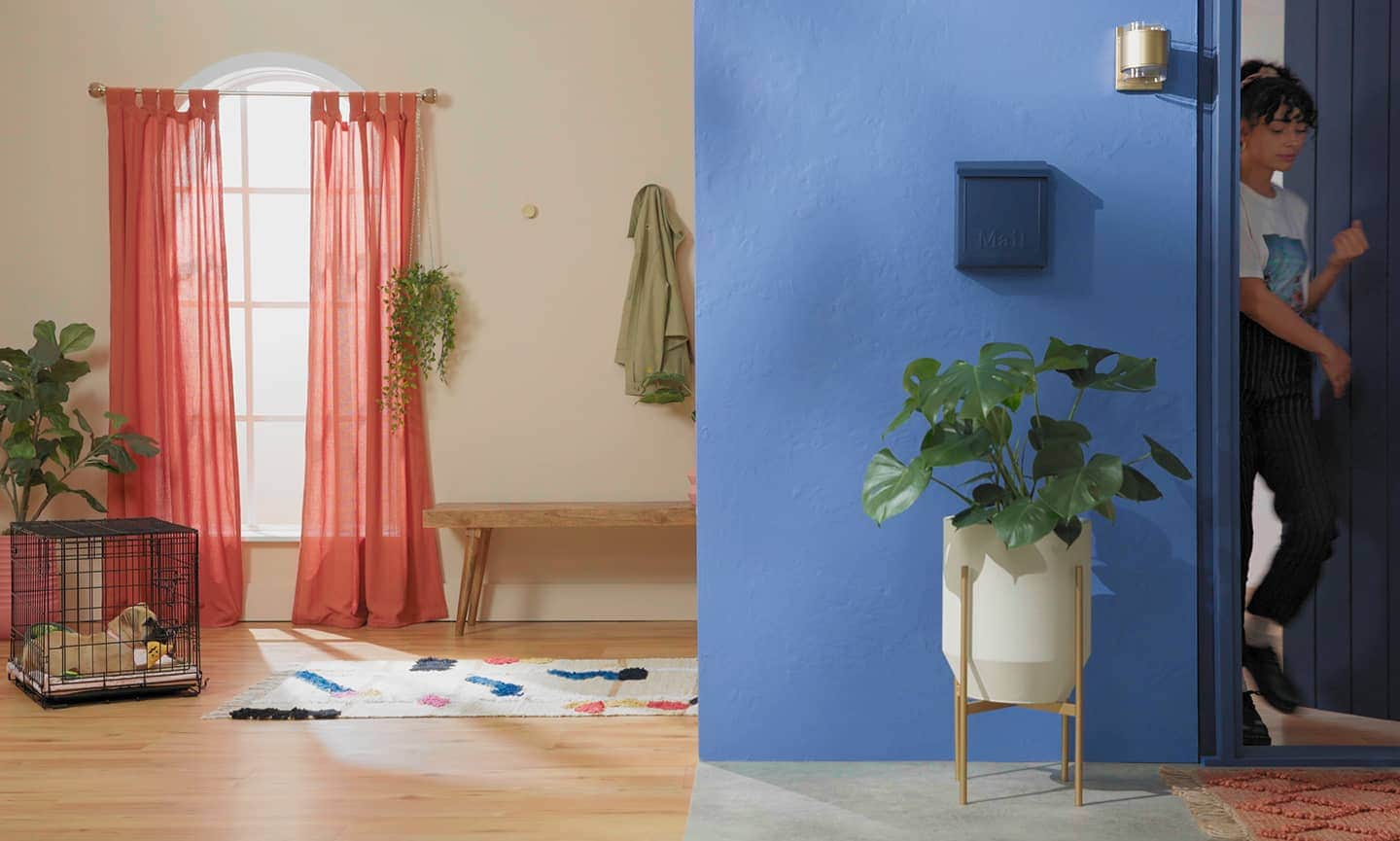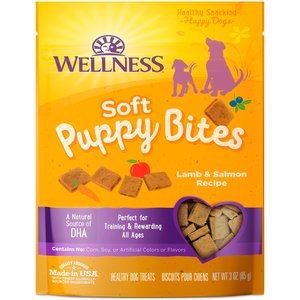If you’ve just brought home a new dog, potty training is probably high on your list of priorities. What if we told you there’s a way to simplify the housetraining process and help your pup feel calm and secure at the same time? It’s true—and it’s all about crate training.
What is crate training? It’s the process of helping your dog learn to spend time in their crate—and ultimately, to adopt it as their own personal space in your home. Crate training taps into your pup’s natural inclination to keep their sleeping space clean—they’re less likely to go potty where they hang out and sleep. Using a crate has benefits beyond just potty training, too; it also helps to keep your dog safe and out of mischief when you’re not around to supervise them, plus it provides a comfy retreat when household hubbub gets overwhelming and your pup wants to relax.
But there’s more to crate training a dog than simply putting them in the crate and closing the door. Dogs need to gradually adjust to spending time in their crates, with lots of positive encouragement from you. Rush the process, and you’ll risk causing your pup stress and anxiety, which can create negative associations with the crate that can be difficult to overcome.
So how do you crate train a dog, and what do you need to know to get started? We’ve got your complete guide to crate training a dog.
The Benefits of Crate Training a Dog
Your dog’s crate might look like a basic enclosure to you, but if you use it correctly, it’ll become one of your pup’s favorite places to be—aside from your lap, of course. Here’s how crates can help both you and your dog:
- Giving your dog a space of their own: Picking an appropriately sized crate and taking time to gradually introduce your dog to it will help them consider the space a comfy refuge. Dogs typically prefer protected areas when bedding down, so a crate can tap into that natural inclination to rest in a safe space.
- Encouraging potty training: One of the biggest benefits to crate training is that it helps streamline the housetraining process, since most pups won’t soil where they sleep. When you learn how to crate train a puppy, for example, you're also learning a key step in their potty training process—two birds, one stone.
- Keeping your pup (and your stuff) safe: Successful dog raising is all about supervision, especially when they're puppies. But the reality is that most pet parents can’t watch their pup full-time. Once again, crate training saves the day! Left to their own devices, most puppies will chew anything they can get their teeth on, but a crate helps to keep your curious pup safely apart from your things (and vice versa) when you’re not able to keep an eye on them.
- Providing a Recovery Zone: At some point in your dog's life, you may need to restrict their movement due to an injury or medical procedure. Making sure that they're happy in their crate will make that job much easier.
Some pet parents worry that “locking their dog up” in a crate could be cruel, but the reality is far different. Yes, it’s true that one benefit of crates is that they keep your dog contained (and out of mischief). But when used properly, your dog’s crate won’t feel like a cage. In fact, it’ll feel just like home! The trick is to introduce the crate gradually, without rushing your dog to adjust to it before you leave them in it alone. Let them settle into the crate on their own terms, and your pup will repay you with calm and happy crate time for years to come.
Supplies Needed for Crate Training a Dog
If you want your dog’s crate to become their happy place, you’ve got to make sure it’s just right for them. Here’s what you’ll need:
The Right Crate
Once you start to look at crates you will find there are lots of options. Choosing the right crate for your own pup isn’t difficult once you consider a couple things:
- Type
- Size
First up is the type of crate, which can fall into two categories: either hard plastic airline-style crates, like the Frisco Two Door Top Load Plastic Dog & Cat Kennel, or wire crates like the Frisco Heavy Duty Fold & Carry Single Door Collapsible Wire Dog Crate. Most pups can learn to be comfortable in either type, but wire crates have more versatility when it comes to door placement and customizing the size of the interior with a divider.
Next, you’ll need to pick the correct size—one of the most important considerations when figuring out how to crate train a dog.
Your dog crate should be large enough so that your dog can stand up, turn around and lie down comfortably, but not much bigger. Although it’s tempting to purchase an oversized crate to give your pup more room, doing so can derail the potty-training process by giving your pup the space to go to the bathroom at one end while staying dry in the other.
Pet parents of puppies, especially large breed puppies, can anticipate their dog's growth by purchasing the largest sized crate their dog will need when they’re fully grown and using an adjustable crate divider to keep the available space inside the right size. The Frisco Fold & Carry Double Door Collapsible Wire Dog Crate comes with a divider and is available in sizes up to XL, so your crate can grow right along with your puppy. Get more tips on choosing the right size crate for your dog.
Other Crate Training Supplies
There’s more to crate training than just a crate. Here’s what else you’ll need:
- Bedding: You’ll need bedding to keep your dog comfortable, but if you're crate training a puppy or an older dog who still needs housetraining, avoid extra-plush dog beds. The extra cushioning might absorb urine and make it difficult to tell if your dog has had an accident inside. Some puppies may be tempted to chew up or destroy overstuffed bedding when left in the crate, too. A simple crate mat like the Frisco Micro Terry Dog Crate Mat is a good choice for pups still acclimating to the crate.
- Treats: Tasty snacks are an important part of the crate introduction process (and any other type of training you want to do with your pup). Small savory treats, like Wellness Soft Puppy Bites Lamb & Salmon Recipe Grain-Free Dog Treats, help reinforce the idea that good things happen inside the crate.
- Toys: For dogs with tons of energy, like puppies, helping them chill out in the crate can be a challenge. That’s where busy toys come into the picture. Giving your pup something to do when left alone inside can help keep them focused and happy until they drift off to sleep. Treat-stuffable toys like the KONG Classic or a West Paw Zogoflex Small Tux Tough Treat Dispensing Dog Chew Toy are tough enough to stand up to most dogs' powerful teeth and can be filled according to your pup’s level of toy unpacking expertise. (Some pups can get frustrated if the treat toy is too jam-packed.) Always test the durability of any toy before leaving your dog alone with it to make sure they can’t bite pieces of it off that could be a choking hazard.
Where Should I Keep My Dog's Crate?
The perfect spot for a dog crate is a location that’s quiet enough for your pup to rest but not so far off that they’re isolated from the household (so the garage or the basement are out). A corner of the living room, dining room or other area where family regularly gathers is an ideal location.
Crate location is particularly important at night, especially for young puppies who often need to go out for a potty trip at least once before morning. You’ll want to put the crate close enough to your bed that you can hear them ask to go out—and somewhere easy for you to get to, so you don’t have to fumble around in the middle of the night. If keeping the crate in your bedroom isn’t an option, consider using a dog monitor near the crate so you can hear when your puppy needs a potty trip.
It can be helpful to purchase two crates, especially for pet parents with larger dogs who require oversized crates that aren’t easy to move around. Keep one in the common area where your pup will hang out during the day, and one where they sleep at night.
How to Crate Train a Dog: Step by Step
One of the secrets to kennel training success is giving your dog plenty of time to feel comfortable inside the crate before closing the door and leaving them alone for the first time. The goal is for your pup to have a positive association with being inside, so that the crate feels like a safe and comfortable resting spot—and you can’t rush that feeling. So remember: The steps below aren’t meant to be done all in one day. Spend as much time as you need on each step to ensure that your dog feels content and stress-free. That’s how you lay the foundation for a lifetime of looking forward to their crate.
Ready to dive into crate training? Here’s how it’s done.

1 Introduce the Crate
Start off the crate training process by keeping the crate door open and letting your pup explore it at their own pace. Toss a treat inside and praise your dog when they go in to eat it, then give them another while they’re in the crate. You can also entice your dog with a busy toy stuffed with treats—anything to make that crate as appealing as possible! Stay happy and upbeat as your puppy explores the crate, making sure to give lots of praise when they go inside. At this stage, keep the door open.
Practice this step as many times as necessary for your dog to get comfortable in the crate. At this stage, the choice to go into the crate is up to your pup. Don’t force them if they seem reluctant. If your dog is hesitant to go inside, you can give treats to reward baby steps in the right direction, like if they glance at it or take a step towards it. These small successes will encourage your pup to keep it up! If they don’t get close to it, simply leave the treats inside for them to collect when they’re ready.
Shop Related Products on Chewy

2 Practice Closing the Door

3 Step Away Briefly

4 Work Up to Longer Stays
How to Crate Train Your Dog: Tips and Tricks
The following simple tips can help speed the crate training process:
- Always give your dog a potty break before putting them in the crate, and don’t forget to take them outside immediately after letting them out. This is especially important for puppies, whose "hold time" is still developing.
- Don’t crate your dog for too long. Doing so might force them to soil inside. Again, this is the biggest concern for puppies, whose “hold time” is roughly their age in months translated to hours. That means a 4-month-old puppy can hold it for about four hours. (Remember, play and excitement can make your pup need to go out more frequently, too.) For adult dogs, avoid crating them for more than four hours. That means that you should plan for a mid-day break if you'll be leaving your dog crated during the work day.
- Feeding your dog's meals in their crate with the door open can help to make it a positive spot. If they’re reluctant to eat inside, place the bowls next to the crate for a few meals, then just inside of it, then finally, at the back of the crate.
- Remember that there’s a difference between “frustration” noises and “I gotta go” noises. If you’ve just returned from a potty trip, a dog whining in the crate for the first few minutes is likely just settling in.
- The crate should never be used for punishment. Remember, the most important aspect of crate training is ensuring that your pup thinks it’s a fantastic place to hang out!
If your dog still isn’t settling into the crate, they may be experiencing separation anxiety or discomfort. Check out our tips on dealing with dog separation anxiety and puppy separation anxiety in particular, and talk to your vet for advice tailored to your unique pup.
But if you follow these tips, chances are that before long, your puppy will begin to happily settle into their crate with ease—and that’s a big life improvement both for them and for you.
Like this story? Check out more of our favorite reads:
Share:


















